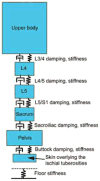Transmission of force in the lumbosacral spine during backward falls
- PMID: 22076645
- PMCID: PMC3438202
- DOI: 10.1097/BRS.0b013e31823ecae0
Transmission of force in the lumbosacral spine during backward falls
Abstract
Study design: Mathematical model, combined with and verified using human subject data.
Objective: (1) To develop and verify a lumped-parameter mathematical model for prediction of spine forces during backward falls; (2) to use this model to evaluate the effect of floor stiffness on spine forces during falls; and (3) to compare predicted impact forces with forces previously measured to fracture the spine.
Summary of background data: Vertebral fractures are the most common osteoporotic fractures and commonly result from falls from standing height. Compliant flooring reduces the force at the ground during a backward fall from standing; however, the effect on spine forces is unknown.
Methods: A 6-df model of the body was developed and verified using data from 10 human subjects falling from standing onto 3 types of compliant floors (soft: 59 kN/m, medium: 67 kN/m, and firm: 95 kN/m). The simulated ground forces were compared with those measured experimentally. The model was also used to assess the effect of floor stiffness on spine forces at various intervertebral levels.
Results: There was less than 14% difference between model predictions and experimentally measured peak ground reaction forces, when averaged over all floor conditions. When compared with the rigid floor, average peak spine force attenuations of 46%, 43%, and 41% were achieved with the soft, medium, and firm floors, respectively (3.7, 3.9, 4.1 kN vs. 6.9 kN at L4/L5). Spine forces were lower than those at the ground and decreased cranially (4.9, 3.9, 3.7, 3.5 kN at the ground, L5/S1, L4/L5, and L3/L4, respectively, for the soft floor).
Conclusion: Lowering the floor stiffness (from 400 to 59 kN/m) can attenuate peak lumbosacral spine forces in a backward fall onto the buttocks from standing by 46% (average peak from 6.9 to 3.7 kN at L4/L5) to values closer to the average tolerance of the spine to fracture (3.4 kN).
Figures




Similar articles
-
Preventing fall-related vertebral fractures: effect of floor stiffness on peak impact forces during backward falls.Spine (Phila Pa 1976). 2008 Aug 1;33(17):1856-62. doi: 10.1097/BRS.0b013e31817bab05. Spine (Phila Pa 1976). 2008. PMID: 18670338
-
Hybrid cadaveric/surrogate model of thoracolumbar spine injury due to simulated fall from height.Accid Anal Prev. 2013 Oct;59:185-91. doi: 10.1016/j.aap.2013.05.024. Epub 2013 Jun 2. Accid Anal Prev. 2013. PMID: 23792617
-
Effect of compliant flooring on impact force during falls on the hip.J Orthop Res. 2006 Jul;24(7):1405-11. doi: 10.1002/jor.20172. J Orthop Res. 2006. PMID: 16705716
-
Shock-absorbing flooring for fall-related injury prevention in older adults and staff in hospitals and care homes: the SAFEST systematic review.Health Technol Assess. 2022 Jan;26(5):1-196. doi: 10.3310/ZOWL2323. Health Technol Assess. 2022. PMID: 35089119
-
Biomechanical considerations of hip and spine fractures in osteoporotic bone.Instr Course Lect. 1997;46:431-8. Instr Course Lect. 1997. PMID: 9143985 Review.
Cited by
-
Effect of the Degenerative State of the Intervertebral Disk on the Impact Characteristics of Human Spine Segments.Front Bioeng Biotechnol. 2013 Dec 16;1:16. doi: 10.3389/fbioe.2013.00016. eCollection 2013. Front Bioeng Biotechnol. 2013. PMID: 25024122 Free PMC article.
-
Stress analysis of the thoracolumbar junction in the process of backward fall: An experimental study and finite element analysis.Exp Ther Med. 2021 Oct;22(4):1117. doi: 10.3892/etm.2021.10551. Epub 2021 Aug 4. Exp Ther Med. 2021. PMID: 34504571 Free PMC article.
-
The degenerative state of the intervertebral disk independently predicts the failure of human lumbar spine to high rate loading: an experimental study.Clin Biomech (Bristol). 2015 Feb;30(2):211-8. doi: 10.1016/j.clinbiomech.2014.09.016. Epub 2014 Oct 7. Clin Biomech (Bristol). 2015. PMID: 25579978 Free PMC article.
-
Variations in situational risk factors for fractures of the distal forearm, hip, and vertebrae in older women.BMC Geriatr. 2021 Mar 31;21(1):214. doi: 10.1186/s12877-021-02157-2. BMC Geriatr. 2021. PMID: 33789569 Free PMC article.
-
Impact forces in backward falls: Subject-specific video-based rigid body simulation of backward falls.Proc Inst Mech Eng H. 2023 Nov;237(11):1275-1286. doi: 10.1177/09544119231207653. Epub 2023 Nov 16. Proc Inst Mech Eng H. 2023. PMID: 37969107 Free PMC article.
References
-
- National Osteoporosis Foundation. [Accessed March 11, 2010];Fast facts on osteoporosis. 2008 Available at: www.nof.org/osteoporosis/diseasefacts.htm.
-
- Chrischilles EA, Butler D, Davis CS, et al. A model of lifetime osteoporosis impact. Arch Intern Med. 1991;151:2026–32. - PubMed
-
- Cummings SR, Melton LJ. Epidemiology and outcomes of osteoporotic fractures. Lancet. 2002;359:1761–7. - PubMed
-
- Jalava T, Sarna S, Pylkkanen L, et al. Association between vertebral fracture and increased mortality in osteoporotic patients. J Bone Miner Res. 2003;18:1254–60. - PubMed
-
- Bliuc D, Nguyen ND, Milch VE, et al. Mortality risk associated with low-trauma osteoporotic fracture and subsequent fracture in men and women. JAMA. 2009;301:513–21. - PubMed
Publication types
MeSH terms
Grants and funding
LinkOut - more resources
Full Text Sources
Medical
Research Materials
Miscellaneous

